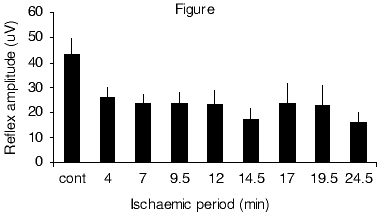
We studied the tendon reflex with the aim of characterising the contributing afferents on the basis of their sensitivity to ischemia. The experiment was done on 12 healthy human volunteers. The left foot was strapped to a foot plate controlled by a servo-motor that could detect force changes about the ankle. Tendon taps were applied to the Achilles tendon with a hammer that was hinged and fell under gravity to deliver a constant blow. A series of 10 responses was recorded at each background contraction of rest, 5%, 10%, 15%, 20% of maximum voluntary contraction (MVC) of the ankle plantar-flexor against the foot plate. Then ischemia was induced in the recorded lower limb by inflation of a blood pressure cuff on the left thigh. Taps were applied to the resting muscle during ischemia at the times shown in the figure and at 2.5 min intervals up to 32.5 min after cuff deflation. Even after our attempts to standardise the delivered taps, we found a large variance within each series of 10 and between subjects. This has been noted earlier (Toft et al, 1991). Coefficients of variations (CV) were high at all contraction levels but decreased for the taps applied at 15% and 20% of MVC. Despite the high CVs, the amplitude, when averaged over the series of 10, increased in a highly linear manner with the contraction level (linear regression, P<0.00001). This result emulates the effect of contraction level on the tonic stretch reflex gain (Neilson & McCoughy, 1981) but has not been previously observed in tendon reflexes. The tendon reflex amplitude, after normalising for background contraction level, decreased significantly (ANOVA, P<0.000001) after 4 min of ischemia to about 50% of the control value and remained depressed throughout the ischemic period. A transient recovery occurred after cuff deflation (ANOVA, P=.00002, data not shown in the figure) when compared with the last ischemic tap amplitude but the response remained depressed for the rest of the measured post ischemic period.

The data indicate that the tendon reflex is mediated by both ischemia- sensitive and ischemia-resistant fibres. The data from the accompanying abstract (Burne & Haque, 2003) suggest that fibres mediating high frequency stretches are more sensitive to ischemia than those mediating low frequencies. Given that taps constitute a broad-band stretch containing frequencies 0.1-100 Hz (data not shown), the high frequency component might be responsible for the quick depression and the low frequency component for the ischemia-resistant component.
Burne, J. & Haque, A. (2003) Proceedings of Australian Physiological and Pharmacological Society, 33:39P.
Neilson, P. & McCoughy, J. (1981) Journal of Neurology, Neurosurgery and Psychiatry, 44: 1007-1012.
Toft, E., Sinkjaer, T. & Rasmussen, A. (1991) Acta Neurologica Scandinavica, 84: 311-315.